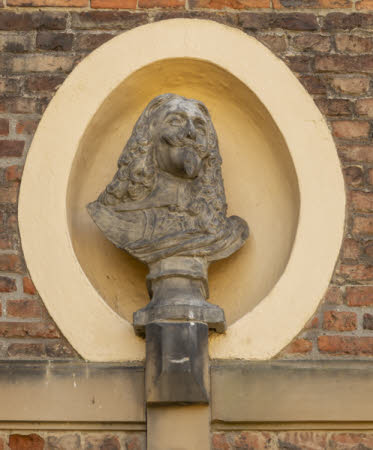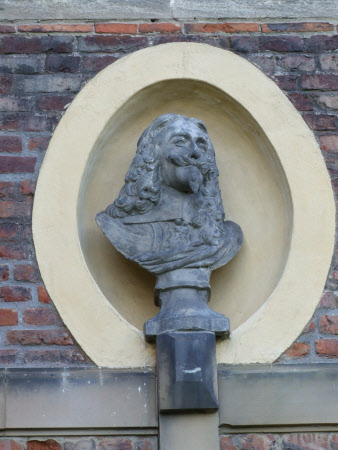Portrait bust of King Charles I (1600-1649)
workshop of John Besnier (fl.1681)
Category
Art / Sculpture
Date
c. 1670 - 1672
Materials
Lead
Place of origin
London
Order this imageCollection
Ham House, Surrey
NT 1140348
Summary
A lead portrait bust of King Charles I (1600-1649), wearing armour and a shirt with a large collar. One of thirty-eight lead busts made for the garden walls of Ham House in 1671-72, perhaps in the workshop of John Besnier, thirty-six of which survive in niches on the walls and on the north façade of the house. .
Full description
A portrait bust in lead of King Charles I (1600-1649), head turned to his left, with long flowing hair, a pointed moustache and goatee beard. He is dressed in armour, a Medusa mask embossed upon his breastplate, under which he wears a shirt with a large collar overlapping the top of the armour. A sash runs over the king’s left shoulder and across his front. Mounted on a waisted plinth. The portrait of King Charles I is one of thirty-six lead busts displayed in oval niches in the garden walls and on the north façade of Ham House, probably installed in 1671-72, and recorded in the 1679 inventory of Ham House. The entire series, originally numbering thirty-eight, was probably arranged in its present positions along the garden walls and on the north front of Ham House by the 6th Earl of Dysart, as part of improvements undertaken between 1798 and 1803. Almost all the busts are portraits of emperors and other classical male subjects, complemented by a series of female busts. The portraits of Charles I and his son King Charles II (NT 1140347) are therefore exceptional in their depiction of real individuals, with both of whom in this case the Lauderdales and Elizabeth Lauderdale’s parents were intimately connected. Catherine Bruce (see NT 1139887) and her husband William Murray were both Scottish by birth and ardent royalist supporters both during and after the Civil War. During the years of the Civil War and afterwards, Catherine Murray and her four daughters remained mostly in residence at Ham, resisting attempts by the Parliamentary Commissioners to seize the house. The Murrays’ eldest daughter Elizabeth married as her second husband John Maitland, second Earl (later first Duke) of Lauderdale, a close advisor to King Charles II. The display of the two busts in some place on the outside of Ham House or its forecourt was therefore a strong demonstration of the family’s loyalty to the Stuart monarchs over several decades. Like the portrait of Charles II, the portrait of Charles I does not seem to derive from a specific sculpted or painted prototype, although the armour broadly corresponds to that seen in the bronze portrait busts of the monarch by Hubert Le Sueur (c. 1580-1658), one of Charles’s court sculptors. The long series of lead busts may well, like other sculpture at Ham House, have been made in the workshops of the Besnier family, perhaps by John Besnier, who received a commission for lead statuary from the Duke of Ormonde in 1681. They were originally painted so that they would appear, at least from a distance, to be made of marble. For a fuller discussion of the garden wall busts and their history and attribution, see NT 1140333. Jeremy Warren January 2022
Provenance
Probably made and installed in 1671-72, to the commission of John Maitland and Elizabeth Murray, 1st Duke and Duchess of Lauderdale. Thence by descent, until acquired in 1948 by HM Government when Sir Lyonel, 4th Bt (1854 – 1952) and Sir Cecil Tollemache, 5th Bt (1886 – 1969) presented Ham House to the National Trust. Entrusted to the care of the Victoria & Albert Museum until 1990, when returned to the care of the National Trust, to which ownership was transferred in 2002.
Makers and roles
workshop of John Besnier (fl.1681), sculptor
References
Avery 2013: Charles Avery, ‘Seventeenth-century Sculpture at Ham House’ in Christopher Rowell, ed., Ham House. 400 Years of History, New Haven/London 2013, pp. 158-77., pp. 172-76, fig. 161.


